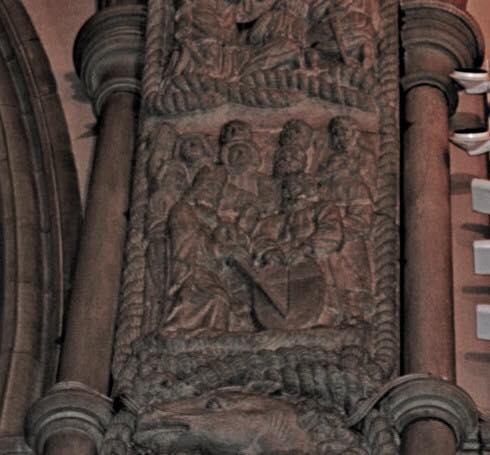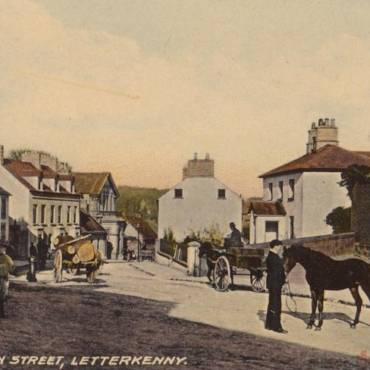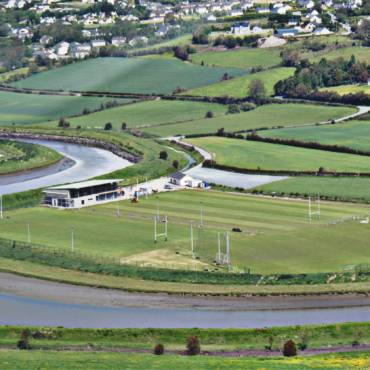St. Patrick’s Day in Letterkenny
With the feast of our patron saint almost upon us, and the parade fast approaching, let us take a quick look at how St. Patrick is connected to our county before observing how the feast day was marked in Letterkenny in days past.
As I’m sure you remember from school, Patrick was kidnapped by Niall of the Nine Hostages and sold into slavery in Ireland. After escaping, he returned to the land of his former captors to promote Christianity. The son of his kidnapper was Conall Gulban, who reigned in the Donegal territory named after him, Tír Chonaill, the Land of Conall.
Conall Gulban is believed to have been the first among Gaelic Ireland’s ruling classes to accept the teachings of St. Patrick and he embraced the Christian faith openly, being baptized by the saint. According to legend, Patrick lifted his crozier and, striking Conall’s battle shield, he caused the royal shield to become miraculously engraved with the sign of the cross. And thus was born the Donegal crest still used today and forming an instant connection for the saint and our county. This seminal moment of the striking of Conall’s shield is depicted in the stone carving of the Columban Arch in St. Eunan’s Cathedral (pictured).
For many years, the observance of the feast day in the town was naturally religious in nature, although there would also be ceilís and gaelic football tournaments. In 1916, papers reported that “The feast of St. Patrick was not, except by the general wearing of the shamrock, marked by any public recognition in Letterkenny, its observance by the Catholic community being of a religious character.” Throughout the day, masses were celebrated by Bishop O’Donnell, Fr. McNeely and Fr. McCafferty, the latter of whom dwelt on “the evil effects of indulgence in strong drink” and for the public “to practice the virtues of temperance and total abstinence”. That night, the National Volunteers held a largely attended dance in the Literary Institute with Charles Ward and Michael McGovern as masters of ceremonies.
Ten years later, following mass in the Cathedral by Bishop McNeely, St. Eunan’s Band paraded the town accompanied by a large crowd while once again a dance was held in the Institute with James Collins as MC.
St. Patrick’s Day 1934 saw a large ‘Blueshirt Demonstration’ taking place in the town with over a hundred uniformed young men and girls taking part in a procession from the Institute around the town. Small groups of people shouted insults at those parading but mostly it passed peacefully as it returned to the Institute where it received an address by Dr. J.P. McGinley. One year later, the town witnessed a large parade of the newly formed Tirchonaill Regiment of the Volunteer Force. Following an open air mass at Rockhill at 9am, they marched from Creeve Road to the Main Street via the Back Road and the New Line Road. “At one point in the parade the whole stretch of the Main Street from the top of the Port Road to Oldtown, as far as eye could see, was filled with the serried lines of the green clad Volunteers, the bayonets of whose rifles gleamed a dull brightness in the dull air.” The parade continued on to Rockhill where the dismiss was given.
Military style parades continued like this sporadically over many years from the LDF, FCA or even the AOH. It wasn’t until 1961 that the town had its first official parade, as we know them today, with businesses taking part. The Urban Council proposed marking the 1500th commemoration of the death of St. Patrick with a large industrial parade and a day-long series of entertainment. Almost fifty businesses and industrial firms from the district took part and the Minister for Local Government, Mr. Neal T. Blaney, T.D., was present to review the turn-out from a platform at the Market Square. The parade was headed by the F.C.A. and three pipe bands took part, as the procession, almost a mile long, made its way up the Port Road and down the Main Street.
Throughout the afternoon, a number of sporting and other attractions took place. At Oakpark, the Letterkenny Motor Cycle Club held a scramble in which twelve riders took part from different parts of Ulster. The local St. Patrick’s Club ran a road cycle race over a fifty miles circuit, twenty-four riders competing. A large ceilí took place in the Literary Institute, organised by the newly formed branch of Cumann na Rinceoiri with Padraig O Cuirrin acting as fear an tíghe. When the ceilí concluded, the band and the dancers went to a platform at the Market Square to continue.
For many years, St. Patrick’s Day was marked locally by Cllr. Patsy O’Donnell receiving an official correspondence from ‘the other Letterkenny’ in Pennsylvania, USA. Upon the discovery of the township of the same name by the people of Letterkenny in the early 1960s, Cllr. O’Donnell kept in regular contact with those in the army depot there and would receive a communication each March wishing the people of the town a happy St. Patrick’s Day.
By 1984, papers were reporting that the largest St. Patrick’s Day parade in the country, outside of Dublin, was taking place in Letterkenny with 20 bands, 600 Boy Scouts, dozens of industrial and carnival floats and children in fancy dress costumes being led through the town by the 28thBattalion Army Pipe Band.
Of course, the annual parade on the Feast Day of our national saint has continued to grow ever since and huge thanks must go to the Chamber of Commerce and all those involved in continuing to make the day such a memorable occasion for all the family. Beannachtaí Lá Fhéile Phádraig daoibh go léir!



